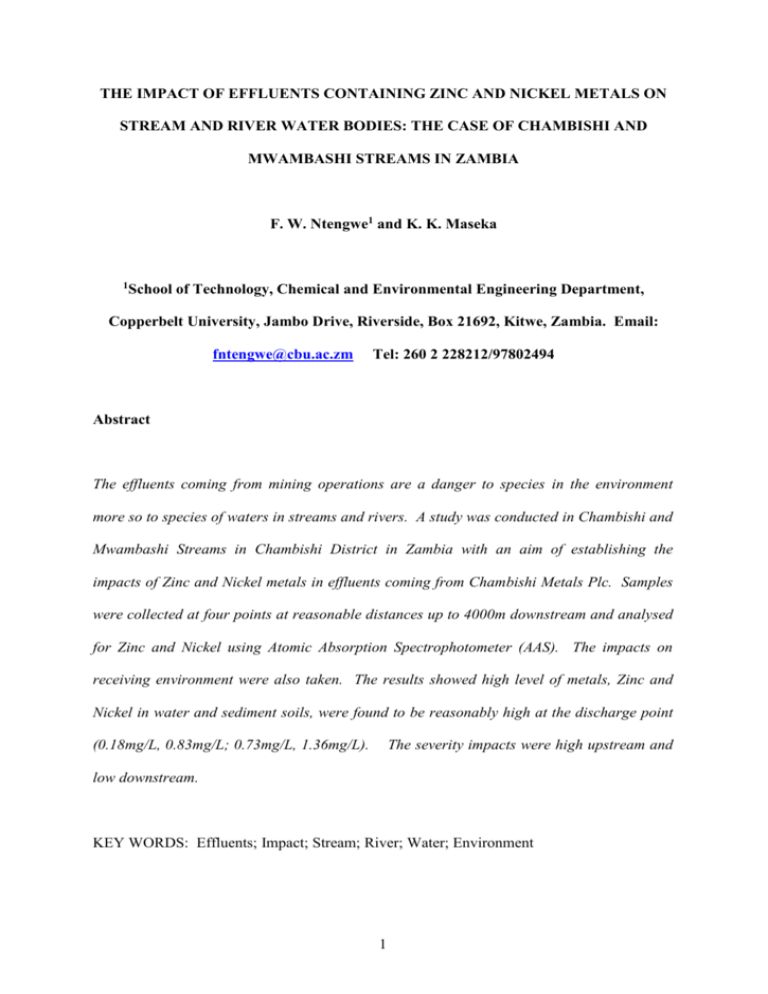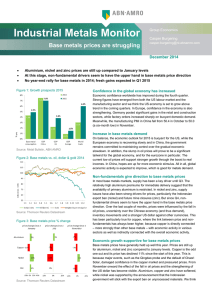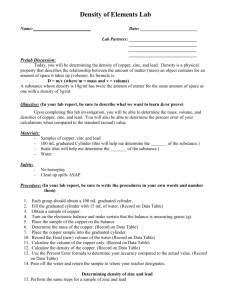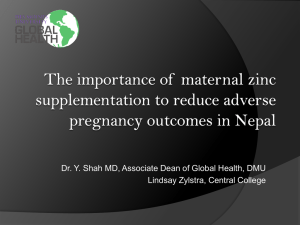the impact of effluents containing zinc and nickel metals
advertisement

THE IMPACT OF EFFLUENTS CONTAINING ZINC AND NICKEL METALS ON STREAM AND RIVER WATER BODIES: THE CASE OF CHAMBISHI AND MWAMBASHI STREAMS IN ZAMBIA F. W. Ntengwe1 and K. K. Maseka 1School of Technology, Chemical and Environmental Engineering Department, Copperbelt University, Jambo Drive, Riverside, Box 21692, Kitwe, Zambia. Email: fntengwe@cbu.ac.zm Tel: 260 2 228212/97802494 Abstract The effluents coming from mining operations are a danger to species in the environment more so to species of waters in streams and rivers. A study was conducted in Chambishi and Mwambashi Streams in Chambishi District in Zambia with an aim of establishing the impacts of Zinc and Nickel metals in effluents coming from Chambishi Metals Plc. Samples were collected at four points at reasonable distances up to 4000m downstream and analysed for Zinc and Nickel using Atomic Absorption Spectrophotometer (AAS). The impacts on receiving environment were also taken. The results showed high level of metals, Zinc and Nickel in water and sediment soils, were found to be reasonably high at the discharge point (0.18mg/L, 0.83mg/L; 0.73mg/L, 1.36mg/L). The severity impacts were high upstream and low downstream. KEY WORDS: Effluents; Impact; Stream; River; Water; Environment 1 INTRODUCTION Streams and rivers are a major source of fresh water in Zambia. The Kafue River, for example, is a major supplier of fresh water to most industries in the Copperbelt region including the mining and chemical industries where large quantities of water are used to wash mineral ores in order to extract metals such as Copper and Cobalt. In the process, they generate effluents, which have potential to pollute the environment. The effluents are discharged into streams and rivers as part of conservation strategy to prevent the Kafue River from drying up and as a way of disposing them as wastes. The wastewaters are pre-treated before discharging to the surface waters of streams and underground waters through percolation and to the atmosphere by evaporation. Acid mine drainage, a condition created by effluents when disposed into stream and river waters, impacts the water quality. Tetra Tech (2001) reported the impact of acid mine drainage on Ely Brook’s water quality as was determined by physical and biological factors. McMenemy (2001) reported the non-survival of fish, which was cropped for one year, in Ely Brook River due to extremely poor survival and growth conditions. Zinc and Nickel are the metals that are used to judge the water quality. Boyne Smelters Limited in Gladstone region of Australia uses Zinc and Nickel among other metals like copper, Iron, Lead and Sodium as parameters for monitoring water quality. The Gladstone Water Board (GWB) in Australia reported Zinc and Nickel to be among the metals that any smelting or mining company would use to monitor effluents for water quality. Fish species are used as one of aquatic environment tools to determine water quality in streams and rivers in Gladstone area (GWB, 2004). The effluents thus can change the ecosystems in streams and rivers if they do not meet stream and river water quality. The result would be that life of species in streams and rivers and man would be impacted. The growth of fish may be retarded or render fish to be absent altogether. The growth and 2 existence of bacteria and planktons may be severely affected. Man may also be affected by the poor quality of water. Masters, (1974) supports this argument when he wrote that metals were toxic to fish and wildlife. Ntengwe (2004) reported cases of not willing to pay bills of water in Lusaka, Zambia because of poor water quality. In order to protect ecosystems in the environment, the introduction of treatment at source or waste reduction at source can be used in addition to the regulations in order to control levels of pollution agents being released into the environment. The government of the Republic of Zambia (GRZ) adopted the National conservation strategy in 1985 and passed the Environmental Protection and pollution control act (EPPCA) in 1990 as a way of controlling and preventing pollution. This also resulted in the formation of the Environmental Council of Zambia as the enforcing agency for effluents and the National Water and Sanitation Council for enforcing the quality of drinking water (GRZ, 1990; WHO, 1993; GRZ, 1995; Katuta, 2004). It was therefore important to study the effects or impacts of wastewater. STUDY AREA The study was conducted in Chambishi District, which is about 25km North West of Kitwe and has a population of close to 8,000 inhabitants (CSO, 1990). The study focussed on the impacts of effluent on water quality of Chambishi and Stream Mwambashi streams (Fig. 1). Roads Fig.1 Chambishi and Mwambashi Streams 3 Chambishi Metals plc is the only major mining company in the area and was originally developed as an open pit mine for Zambia Consolidated Copper Mines Limited. The pit was capable of producing 24 tonnes of copper per year. In 1972, the underground mine was developed. This boosted production to 45,000 tonnes per year. Six years later, the company began to produce cobalt and sulphuric acid. The total cobalt produced per year was 23,000 tonnes. In early 1990s the company was sold to Anglova who changed the name to Chambishi Metals Plc and are running it effectively than the predecessor. The climate in the area comprises three seasons, a warm and wet season, which starts from October and ends in April, a cool and dry season, which starts in May and ends in July and a hot and dry season which begins from August and ends in October. The town lies in the medium rainfall belt of Zambia. The rain begins in October and ends in April. It is associated with the South West and North East winds. The South West Winds blow from the Atlantic Ocean to the Democratic Republic of Congo (DRC) and is the air that brings heavy rainfall to the area in the months of December, January and February. The North East Wind is associated with little or no rainfall. A large percentage of people in the study area are farmers and only a few depend on mining activities for their livelihood. The crops grown in the area include maize, tomatoes, onion, carrots, cabbage and rape. Cattle, goats, sheep and chickens are reared by a few people. The majority of farmers practice Peasant Farming while a few carry out Commercial Farming. OBJECTIVE OF THE STUDY The purpose of the study was to evaluate the impacts of effluents coming from the engineering unit operations of Chambishi Metals Plc on the receiving environment. The specific objectives were to determine levels of Zinc and Nickel in stream water and 4 sediments in order to assess the extent to which they impact the environment, the presence of living species in the stream water and the water use from the stream. METHODOLOGY The impacts on fish and phytoplanktons were obtained by the observation method using cooked maize husks and microscopic observation respectively. A questionnaire was administered to the community around the area in order to obtain responses on the use of water in the stream by people and animals. The levels of Zink and Nickel were obtained by collecting water and sediment samples from five sites; the Tailings Dam 6 inlet and outlet, New Dam, Chambishi Bridge and Mwambashi Stream at distances zero, 1250, 2500, 3500 and 4000 metres respectively and analysing using Atomic Absorption Spectrophotometer method. The method is used for quantitative determination of metals. Firstly, the wavelength at which the metal could be detected was established. Then the solution was aspirated into the flame where it was vaporised. Atoms of the metal were excited to higher levels. The energy absorbed by the metals was measured and the concentration was then read from the calibration curve obtained by analysing standard solutions. The absorption of energy followed Beer Lambert’s Law (Skoog et al, 1976). The pH of each sample collected at each point, for the period of four months, was measured using the pH meter in order to observe the changes at each point in each month. The results were reported as averages. IMPACTS OF ZINC AND NICKEL The sources of Nickel are arsenide and sulphide ores. Nickel is used for alloying, as a catalyst in chemical reactors, for battery making and metal plating. It is deposited in rivers 5 and streams through discharges of effluents from mining operations. Its route of exposure to humans, animals, and birds is through drinking contaminated water and dust from the atmosphere. Its health effects include; the disturbance of respiratory system and asthma, birth defects, vomiting and damage to Deoxyribonucleic Acid (DNA) at high concentrations. Lawrence et al (2004) reported negative effect of Nickel on abundance of phototropic organisms like Algae and Cyanobacteria. Zinc is a metal used in galvanizing and alloying. It is also used in manufacturing electric goods, dying, insecticides and cosmetics. Zinc makes up 0.0005%-0.02% of earth’s crust. It is listed as one of the hundred and twenty nine (129) priority pollutants (Roy, 1997). Zinc has been associated with impairment of river and stream water quality for many years. For example, the State of Texas (2005) reported rivers as not meeting their aquatic uses due to toxic metals; Wichita and Middlefork Rivers lost their aquatic uses due to selenium, Neches River below Lake Palestine due to lead, and Neches River above Lake Palestine due to high level of Zinc. Peplow (2000) reported that elevated concentrations of Cadmium, Copper, Selenium including Zinc in stream waters and sediments reduced species diversity and abundance in aquatic communities. Kramer (1976) found elevated levels of lead, Zinc, Cadmiun and Copper in Flat River water. Zachritz (1978) and Czarnezki (1987) found elevated levels of Zinc and Lead in Big River water. Schmitt and Finger (1982) found elevated copper, iron, lead and Zinc in Big River during periods of high flow. All the above cases are near mining operations. A study on impacts of treated wastewater to Krka River, Slovenia, conducted by Cotman et al (2001) recommended a reduction of substances in industrial effluents like Zinc and non-biodegradable organic compounds that cause toxicity to aquatic life. The impacts of Zinc on humans include fainting, nausea and stomach disorder. 6 This is the reason why it was necessary to assess levels of Zinc and Nickel in the streams and because they interfere with water quality. SOURCES OF EFFLUENTS Fig. 2 shows the processes in which copper and cobalt were produced at Chambishi Metals Plc. It also shows areas in which liquid wastes (effluents) were released to the environment. The feed at the smelter included slag, magnesium oxide, lime and coal. The feed materials at roaster plant included Zimbabwe Pyrite, Zaire Pyrite, flocculants, water, oxygen and heat. Magnesium oxide was used as catalyst to catalyse the reaction in which ground slag, lime and coal were used in the reaction. Fig. 2 Flow Diagram of Cu and Co Production Showing Sources of Effluents The reactions in the Smelter Furnace reduce the Nickel bearing mattes such as Copper-Nickel to Copper and Nickel sulphides. Further treatment removed copper and left Nickel in the residue, which was sent to the Tailings Dam 6. Newton (1959) demonstrated that in the Roasting Plant, the sulphide ores are oxidized to oxides (Equations, 1, 2, and 3). 7 2ZnS + 3O2 = 2ZnO + 2SO2 (1) FeS2+11O2=2Fe2O3+8SO2 (2) 2Cu2S+3O2=2Cu2O+2SO2 (3) The Roaster, therefore, generated the needed Sulphur Dioxide feed in the production of Sulphuric Acid at the Sulphuric Acid Plant. Newton (1959) presented facts about the roasting process. He explained that, the roasting begins at the surface of particles and it continues while the particle develops a porous coating through which molecules diffuse into the inside until the reaction goes to completion. Coulson et al (1994) presented similar views. In his case a particle was presented as a core model in which the reaction begins at the surface towards the inside and that each particle decreases its size as reaction proceeds until it is finally consumed or reacted completely. The time for converting ZnS, FeS, and Cu2S in the roasters could be determined. This agrees well with Newton’s assertions. Laws of mass transfer between the two films are also obeyed. The leaching of oxides removed Copper and the residue containing Zinc and Iron were sent to the Tailings Dam 6. Cobalt and Copper Ores were treated by reduction smelting in the electric furnace where two layers formed; a red alloy containing mainly copper and a white alloy containing mainly Cobalt. Cobalt usually occurs with Copper and Copper-Nickel Ores, for example, CoAsS as Cobaltite or CoAs2 as Smaltite. The countries with large deposits include the Democratic Republic of Congo (DRC), the United States of America (USA), Canada and Zambia. In electro-refining of Cobalt, Cobalt was deposited on stainless steel cathode in four or five days after which it was removed by stripping from the cathodes. Cathodes were then dipped 8 in nitric acid to dissolve patches of cobalt and then dipped in gelatine in order to renew them. The process used direct current to deposit the metal. The residue formed in the reactors was sent to Tailings Dam 6. Copper production at the Tank House was also by electro-refining and electro-wining processes where the copper was removed from anodes, which came from the Smelter and was deposited at the copper cathodes. Faradays law of electro-deposition applied (Newton, 1959). Copper was removed from solution while Zinc, Nickel, Iron and Cobalt remained in solution. Cobalt was later removed but Iron, Zinc and Nickel were discarded to the environment with effluent. Electro-refining reactors have anodes and cathodes with potential applied across them and the current distributed over the surface. The application of potential across the reactors results in polarization of the electrodes into anode (positive) and cathode (negative). The polarization results into the deposition of metal and evolution of gas at cathode and anode respectively. The cathode reactions reduce the copper and cobalt ions in solution to copper and cobalt on the cathodes while the anode reactions form copper and cobalt ions which go into solution. Oxygen is also released at the anode by the reaction of sulphate and water molecules. The sulphur dioxide reaction with water resulted in sulphuric acid production. The temperature of Sulphur Dioxide (S02) has to be reduced from 80oC in the roaster in stages of 50oC, 30oC and finally to 15oC at which it reacts with water to produce Sulphuric Acid (H2S04) (Newton, 1959). Spillages of the acid end up as effluent going to the environment. The pH control was thus essential in order to prevent damage to stream water life and animals. Lime plays an important role in the neutralization of industrial effluents. 9 Effluents from Copper Tank House and Roaster were mixed and neutralised before the effluent was discharged to slimes dam for disposal. THE STUDY MODEL The assumptions that were made for the study were that the effluent from the mining operations was carrying the undesired pollutants Zinc and Nickel metals. That the pollutant concentration was highest at the discharge point. The level of concentration would then decline as the effluent entered the Tailings Dam 6 (TD6) and Chambishi Stream due to dilution with water. That the level of the metals would decrease further as the distance increased from the point of discharge. That Zinc and Nickel would move to the sediments depending on the pH and the availability of ionic species in water that would react or associate with them. The impacts would be categorised as severe (Negative) and beneficial (Positive). The water pollution behaviour was then studied according to synthesised Water Pollution Declining Model as shown in Fig. 3. Fig. 3 The Water Pollution Declining Model (WPDM) for Zinc and Nickel pollutants in effluents from mining operation. 10 RESULTS AND DISCUSSION The study revealed that there were very few people living in the area. The poor water quality in the streams had resulted in people opting to settle where the quality of water was good. The animal population comprised animals domesticated by the people. They included goats, cattle and chickens. There were no wild animals around the streams. One assumption could be that animals did not like polluted water because it tasted salty. Although wild pigs for example, like salty waters, none of this type of animals was observed in the area. The plant population was found to be scanty and few aquatic lives existed as was demonstrated by the non abundance of fish in some parts of Chambishi and Mwambashi Streams. The fish counts revealed a decreasing number towards the discharge point of effluents and an increasing number down stream (Fig.4). The fish that was found in the dams was not abundant and almost all exhibited stunted growth as stated by McMenemy (2001). The phytoplankton counts were found to increase down stream and decrease upstream indicating that the effluent from the mine had an effect on them but the fish fish increased as plankton increased downstream. This signified that the fish could not be abundant in areas where planktons were reduced. The pH was found to be regular during the entire study period (standard pH6 to 9) (WHO, 1993). An observation on the effluents released from the mine to Chambishi Stream revealed a blackish colour from the source to Tailings Dam 6 indicating turbidity more than the standard value of 5NTU. The water was clear from Tailings Dam 6 up to Mwambashi Stream. The blackish colour was reduced because most of the solids settled out in the dam due to sedimentation. 11 20 No. 15 10 5 0 -5 0 1250 2500 3500 4000 Distance from discharge of effluent (m) pH Fish Plankton Fig. 4 Variations of pH, fish and Planktons with distance from discharge of effluent The effluent discharge from Chambishi Metals Plc was found to contain 0.73 mg/L of Nickel and 0.18 mg/L of Zinc. The pollution load to the dams and streams was also represented by the same levels at the point of discharge. The daily and yearly pollution loads would depend on the flow rate of effluent and the concentration load of the elements in the effluent. The levels of Zinc in water samples were found to be highest at the inlet of Tailings Dam6 (0.18ppm) and lowest at Mwambashi Stream (0.05ppm) as can be observed in the results in Fig.5. This demonstrated that there was some form of treatment both at the Tailings Dam 6 and along the stream; a process called self cleansing and dilution effect. The sedimentation process removed solid particles and reduced turbidity living the water fairly clear. As the effluent was released into the stream, dilution effect lowered the concentration of Zinc in the stream water. The concentration of Zinc was reduced further as the water travelled along the stream. The level of Nickel was found to be higher than that of Zinc at all the sampled points in the streams and was found to be declining, like those of Zinc, with distance away from the discharge point (Fig. 5). Nickel levels were also found to be higher at the inlet of Tailings Dam 6 and lowest at Mwambashi Stream. The results 12 therefore suggest that the effort of treatment by the dams was bearing fruit. However, the effort seemed to be inadequate because the level of Nickel released into the Chambishi water was higher than the values recommended by the World Health Organization (WHO) and Government of the Republic of Zambia (GRZ) Statutory Instruments of 14th May 1993 (WHO, 1993; GRZ, 1993). The WHO recommendation is 0.05mg/L for Zinc and Nickel if the water is to be used for drinking. Metal Level (mg/L) The results therefore indicate that after 4000m down the stream from the point of discharge, the water complies with WHO requirements for Zinc and Nickel and if 2 1.5 1 0.5 0 0 1250 2500 3500 4000 Distance from discharge (m) consumed by man and animals, would Znsed Znswat Nised Niswat induce little undesirable effects associated Fig. 5 The variation of Nickel and Zinc with them. with distance from the discharge. The impact score based on a scale of 1 to 100% revealed that the quality of environment was impacted 50% negatively (severity) particularly on vegetation in Chambishi Stream. The impact on surface water and sediments was based on the results analysis. Further examination of the impacts revealed that the level of severity (Negative) impacts was higher than positive (beneficial) impacts upstream while the beneficial impacts were higher than severity down stream in all the cases. The individual impacts can be seen in Fig.6 and 7. 13 Severity or beneficial (%) Severity or benefit (%) 100 80 60 40 20 0 SevUS BenefUS Swat SevDS Sed. BenefDS 100 80 60 40 20 0 SevUS Man BenefUS Animal SevDS Fish BenefDS Biota Fig. 6 Impact on Surface water (Swat), Fig. 7 Severity/ beneficial impacts on man and sediments (Sed) animals, fish and other biota (Plankton) This signified that any living thing that used water in the streams would accumulate high levels of metals. It could also imply that the fish in the dams and streams accumulated a lot of metals to levels that could be toxic to predators. The Agency for Toxic Substances and Disease Registry (ATSDR) (2000) reported that Nickel accumulates significantly in some aquatic organisms including phytoplankton and sea weeds and that if such levels adversely affect the ecology then size and quality of fish catches would be impacted. A fish advisory in Vermont recommended reduced consumption of fish by the community because of fish toxicity from metals. The Vermont Department of Health (VDH) (2000) and VDEC (1992) then issued Health Alert that people should limit the consumption of fish caught in Vermont Waters. The Chambishi scenario could not be different from the Vermont one. Some humans in the area fished from the dams but were not able to use water from the stream for domestic use within the 4km distance. The fish in streams were found to be stunted in growth, as stated earlier, when compared to the same type of fish in Lwangwa River which does not receive discharges of effluents from mining operations. This implied that the water was unsuitable for healthy fish habitation (Sadar, 1996). The fish abundance was tested using cooked solid husks of maize. The handful lumps of cooked husks were placed in the 14 water half a metre from the bank of the stream in order to call the fish. The fish came to eat the husks but the numbers differed from point to point. The numbers of fish that came to eat husks increased at points down the Chambeshi Stream and decreased at points up the stream in a ratio of seven to three except the dams downstream where the fish increased in numbers. The decrease of fish upstream represented a severity impact of 70% upstream and 30% down stream for surface water. The numbers of fish that came to eat husks at the New Dam were found to be more than those from Tailings Dam 6 (TD6) in a ratio of four to one. This meant that the severity impact was 75% for TD6 and 25% for the New Dam. The severity of water use by the community represented 75% for non use and 25% for fishing and other uses. Only 15% of the animals domesticated by the community had access to Chambeshi and Mwambashi Stream waters while 85% relied on other sources such as borehole water. The levels of phytoplankton in water samples taken at different points revealed a decrease of nine to one upstream representing 90% and 10% severity upstream and downstream respectively. In general the impacts were high upstream and low down stream. When compared to the decreasing levels of Zinc and Nickel in water and sediments in the downstream, the results of severe impacts were also found to decrease downstream. Therefore, a direct link between level of Zinc and Nickel to the severity of impacts was established. The severity of impacts on soil sediments was based on phytoplankton counts which showed a severity ratio of four to one upstream and the same beneficial impact ratio downstream. Acid mine drainage is also one of the frequent causes of poor water quality apart from metals. Although neutralisation is practiced at Chambishi Metals Plc, the effects of fluctuations in neutralisation could be observed in Chambishi Stream. In almost all areas accommodating 15 mining operations in the world, the studies have revealed high levels of metals particularly Zinc and Nickel. The Ely Copper Mine Report in Vershire, Vermont revealed levels of Zinc and Nickel in Ely Brook River to be 1300mg/L and 73mg/L for surface water respectively and 160mg/L and 26mg/L for sediments taken from the river (VDEC, 1992). The values were found to exceed the Ambient Water Quality Criteria (AWQC) standards (USEPA, 1993, 1999). Brigden (2002) observed that the 2001 data in the Kishon River Masterplan Report showed that Zinc and Nickel levels were above the discharge limits and that effluents still contained significant quantities of metals including Zinc and Nickel. In Nigeria, the recommended limits for discharge into surface water are 0.1mg/l for Zinc and <1mg/L for Nickel (FEPA, 1991). A typical concentration of Zinc in the stream of Arizona was found to be 0.05mg/L above an open pit mine (Roy, 1997). The Zambian discharge limits into surface water are 10mg/L for Zinc and 0.5mg/L for Nickel (GRZ, 1993). The results of the study showed that Zinc level complied with the Zambian standard but Nickel did not. The Nigerian standard is stricter than the Zambian one while the World Health Organization standard was met by Zinc level but not that of Nickel. The pH values were higher upstream than downstream (Fig.4). It could therefore be observed that streams and rivers receiving effluents from mining operations do not retain the natural existence due to the impacts associated with metals. CONCLUSION AND RECOMMENDATIONS The results showed that the absence of abundant aquatic life in Chambishi Stream suggested that Zinc and Nickel levels had a long term effect on the ecosystem. The non-use of water from the stream by the community also signified that they were aware that the water was 16 unsuitable for domestic use. The results further demonstrated that levels of Zinc and Nickel could be high in animals and birds that drunk water from the streams. For example, dogs, goats, birds and cattle. The levels of Nickel were found to exceed the local and international standards by s mall margin. However, the metals were found to be decreasing down-stream and increasing upstream as postulated by the Water Pollution Declining Model (WPDM) developed for the study. The self purification process of the stream was found to be inadequate upstream but good downstream. The high level of Nickel seemed to suggest also that the removal process using dams or lagoons was marginally ineffective. While the Mining Company should be commended for her efforts to ensure that the environment is not impacted by the effluents coming from her engineering operations as demonstrated by the construction of dams that are used to treat the effluent naturally, sludge which is disposed through indiscriminate methods around the plant area are carried by rain water to Chambishi Stream and hence pollute the water. The dams were not able to adequately reduce levels of Nickel down to levels recommended by both the World Health Organization (WHO) and the Environmental Council of Zambia (GRZ, 1993; 1995). This, therefore, calls for an improvement to the system so that it can be efficient. There are many ways in which the system could be improved. One of the methods could be to reduce the concentration of metal carrying solids at the source as sludge, which could then be disposed at Landfills. This can be achieved by putting a sedimentation tank between the source and Tailings Dam 6. The unit uses Stokes Law which states that particles will settle under gravity with a velocity equal to the terminal settling velocity in order to settle out the solids (Coulson et al, 1991). Neutralizers, flocculation agents and precipitators may be added as required in order to enhance the removal of solids and metals and hence turbidity. Zinc 17 and Nickel can be precipitated in order to reduce the level in the effluents. This method works well at the International Metals Company (INCO) in Ontario Canada where they are treating wastewater from mining operations and sending it to the environment in its natural state. The second method could be to construct additional dams with adequate retention times and with plants that can enhance the removal and retention of metals so that the effluent from the dams leaves with low levels of metals and solids. This method not only reduces turbidity but also encourages the restoration of a healthy ecosystem. The third method is to recycle the effluents back into the engineering operations so that more Nickel could be removed from the effluents. Recycling is one of the many methods used in reducing pollutants in effluents. Rawlings (2002) elaborated the bio-processing of Zinc and Nickel using the Thiopaq Process. The process was used to treat Zinc contaminated ground waters at Budelco Zinc Refinery in Netherlands and Kennecott Bingham Canyon Copper Mine in Utah where recovery of more than 99% copper at pH 2.6 was achieved (Boonstra et al). Rowley et al, 1997 reported a bio-sulfide process that uses both chemical and biological methods that operate independently in the removal of metals such as Zinc and Nickel. As the major metals being processed at Chambishi Metals are Copper and Cobalt only, the removal of metals such as Zinc and Nickel could be a challenge to Chambishi Metals or other investors who would wish to consider investing in Zinc and Nickel production in the area. It is, therefore, hoped that Chambishi Metals would consider the given recommendations in addition to what currently exists at the plant in their future strategies of protecting the environment. It is a known fact that even if the effluents are treated with the application of high costs that go in the efforts to lower undesirable elements that reduce the quality of stream and river water, the full restoration of ecosystems can only be achieved in the long term and not in the short term. The treatment of acids and removal of metals supported by 18 the plantation of acid resistant grass and trees would help to restore the quality of streams in the area. ACKNOWLEDGMENT We would like to thank Chambeshi Metals Company and her workers for allowing and assisting us to conduct the study at their premises and mine area. We are also grateful to the Copperbelt University for providing us with facilities that were used during the study. We finally wish to thank Katuta Bruce, the technologist, for assisting in analysing the samples. REFERENCES ATSDR, (2000). Toxicological Profiles on CD-ROM Version 3:1. Agency for Toxic Substances and Disease Registry, U.S. Public Health Service. CRC Publishers. Boonstra, J., Vanlier, R., Janssen, G., Djikman, H., and Buisman, C. J. N. (1999). Biological treatment of acid mine drainage. In: Biohydrometallurgy and environment toward the mining of 21st century. Process Metallurgy 9B. Elsevier, Amsterdam. 559-567. Brigden, K. and Stringer, R. (2002). A critical assessment of the Kishon River Masterplan Report published by the Ministry of Environment, the State of Israel, July 2001. Cotman, M., Zagorc-Koncan, J., Droic, A. (2001). Study of impacts of treated wastewater to the Krka River, Slovenia. Water Science Technology 44(6): 47-54. Coulson, J. M., Richardson, J. F. (1991). Chemical Engineering; Particle Technology and Separation Processes. Vol. 2. 4th Ed. Pergamon Press, Oxford. PP 100, 103-4. 19 CSO, (1990). Census for Population, Housing and Agriculture. Vol. 2. Copperbelt Province, Central Statistics Office, Lusaka, Zambia. Czarnezki, J. M. (1987). Use of the pocket mussel Lampsilis Ventricosa, for monitoring heavy metal pollution in Ozark Stream. Bull. Environment. Contam. Toxicology 38: 641-646. FEPA, (1991). Guidelines and Standards for Environmental Pollution Control in Nigeria. Federal Environmental Protection Agency, Nigeria. Gladstone Water Board, (2004). Indicator: Water quality and consumption. http://www.sustainablegladstone.com/indicator/waterquality GRZ, (1990). Environmental Protection and Pollution Control (EPPCA) Act No 12 of the Laws of Zambia. GRZ, (1993). Statutory Instrument. 14th May 1993. Government of the Republic of Zambia. Lusaka. GRZ, (1995). Water Act No 55 Cap 198 of the Laws of Zambia. Hardam, S. A. (1976). Industrial Wastewater Management Handbook. McGraw-Hill, New York. Katuta, B. (2004). Diploma Thesis. Copperbelt University. Kramer, R. L. (1976). Effects of century old Missouri Lead mining operations upon the water quality sediments, and biota of Flat River Creek. M.S. Thesis, University of Missouri, Rolla, Missouri. Lawrence, J. R., Chenies, M. R., Roy, R., Beamer, D., Fortin, N., Swehone, G. D. W., Neu, T. R., and Greer, C. W. (2004). Microscale and molecular assessment of impacts of Nickel, nutrients and oxygen level on structure and function of river biofilm communities. Applied and Environmental Microbiology 70(7): 43264339. 20 Lee, J. C. (1994). Reactor Design. Coulson and Richardson. Chemical engineering. Vol.3. 3rd Ed. Pergamon press, Oxford. PP 184-5. Masters, G. M. (1974). Introduction to Environmental Science and Technology. John Wiley & Sons. New York. PP 118-119. McMenemy, J. (2001). District Fisheries Biologist for the Vermont Department of Fish and Wildlife. Waterbury, VT. Personal communication July 2001. Newton, J. (1959). Extractive Metallurgy. John Wiley & Sons Inc., New York. PP 452-455, 465-472. Ntengwe, F. W. (2004). The impact of consumer awareness of water sector issues on willingness to pay and cost recovery in Zambia. Physics and Chemistry of the Earth 29 (2004) 130 -1308. Peplow, D. (2000). Environmental impacts of hard-rock mining in Eastern Washington. University of Washington. Fact Sheet No. 8. Rawling, D. E. (2002). Heavy metal mining using microbes. Annual Review of Microbiology 56: 65-91 Roy, J. I. (1997). Environmental Contaminants Encyclopaedia. Rowley, M., Warkentin, D. D., and Sicotte, V. (1997). Site demonstration of bio-sulfide process at former Brittania Mine. In: Proceedings of the 4th International Conference on Acid Rock Drainage, 31 May to 6 June 1997. Vancouver, British Columbia IV:1531-1548. Sadar, M. H. (1996). Environmental Impact Assessment, 2nd Ed., Carlton University Press Inc. Ottawa. State of Texas, (2005). Surface water quality in Texas. Environmental profiles. Texas. http://www.texasep.org 21 Schmitt, C. J., and Finger, S. E. (1982). The dynamics of metals from past and present mining activities in Big and Black River watersheds. Southern Missouri Final Report for USCODE, St Lous District, Project DACW 43-80-A-0109. Skoog, D. A., and West, D. M. (1976). Fundamentals of Analytical Chemistry. 3rd Ed. Holt, Rinehart and Winston, New York. PP 296-298, 505-508. Tetra Tech NUS Inc., (2000). Final hazard ranking system package for Ely Copper Mine, Vershire, Vermont. NPL-U36-2-1-R1. Wilmington, MA: Prepared for USEPA. USEPA, (1993). Water Quality Criteria. Washington DC: Office of Water, Health and Ecological Criteria Division. pp 294. USEPA, (1999). National recommended water quality criteria-correction: U. S. Environmental Protection Agency, Office of Water. Vermont Department of Environmental Conservation VDEC, (1992). Ely Copper Mine, Beamville Road, Vershire, Orange County, Vermont: Inspection. Screening Site Waterbury, VT: Department of Environmental Conservation, Vermont Agency of Natural Resources. PP 20. VDH, (2000). Health Alert: Vermont Department of Health recommends that people limit their consumption of some fish caught in Vermont Waters. Available: http://www.healthyvermonters.info/hp/fish/fishalert.shtml. WHO, (1993). World Health Organization. Guidelines for Drinking Water Quality. 2 nd Ed., Vol. 1, Recommendations, Geneva. 22






